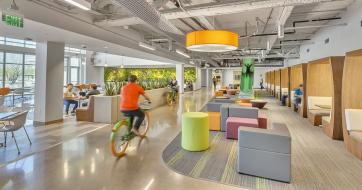
When you begin your search for fuly furnished office space, one of the first questions you’ll consider is “How much space do we need?”
If you rent a fully furnished office space that’s too small, you’ll end up right back where you started: Struggling to complete work in a cramped space, climbing over each other and equipment, and embarrassed to bring clients or family into your work environment.
Then again, you are trying to grow a business. You need to protect your cash flow. You don’t want to pay for more space than you need. Every foot of unused space is wasted money that could be used elsewhere every month.
So how much space should you rent? Well, we have to consider a few things…
First, let’s acknowledge that you’ll never have the right amount of space. Your business will change often. You’ll hire and lose team members. You might buy or sell a piece of equipment. Jenny needs her big potted plant beside her, which takes up space in the aisle. It will never be perfect.
Your business will change often, but you’ll sign a rental agreement for at least a year. There will always be moments of discomfort, whether that means everyone is cramped, or you routinely get frustrated every time you look at that empty office.
In most cases, you can’t shave off a few feet without moving a wall. That isn’t practical, anyway. In some turnkey office spaces, however, you can adjust the amount of space you rent if the property allows. For instance, you can expand your agreement from two offices to three without construction or too much negotiating.
Our advice is to consider your company beyond the first year. Consider your future growth as well. If you expect to have 50% more people working for you before you expect to change locations, you’ll need an office with room for newcomers. If things go as planned, what will your company look like in three, five or ten years?
How much space you need will depend on your business and team. If, for example, you need large pieces of equipment like an architect’s printer or a over-sized copier, your numbers will deviate from the averages, but these will get you started. (Source)
For more specific information regarding your needs, check out this office space calculator.
Keep in mind that spaces of equal sizes aren’t equally usable. “Look for spaces that are more efficient, like rectangular spaces versus angled corners of a building,” recommends real estate advisor Denis Mehigan. “No two spaces with the same square footage are the same. Floor plan and layout matter.”
Coworking spaces and executive office suites provide a lot of flexibility to businesses in terms of space. In these arrangements, shared spaces and amenities can be scaled up or down to save you money. You can actually have access to more space than you rent.
[Tweet “Spaces with shared amenities allow you to access more space than you rent.”]
For instance, let’s say you want access to a conference room, but you only intend to use it once each month when a client visits. It would be wasteful to rent an office with a conference room for such little use. Then again, you want to impress that client.
It’s possible to rent offices in a building that allows you to share amenities with other tenants. You could rent a few offices on a floor with a conference room. Even though you only rent a small portion of the building, you still get the conference room. It’s possible to share reception areas, bathrooms, and lunch/break rooms as well.
If one of the reasons you need a fully furnished office space is because you expect to entertain clients, it’s smarter to opt for office space that’s slightly bigger than you need.
“The spaces we inhabit influence how we act and how we feel,” says architect Barbara Holzer. Your office space will affect the feelings of your clients when they visit.
The size of your office can affect the perception of your company in several ways, so be careful. A roomy office where everyone is comfortable exhibits success and financial security, both traits that might make someone want to do business with you.
An office that’s too large for your company (and has lots of unused space) exhibits wasteful spending and poor planning. Your clients and customers won’t like to see that.
Then again, cramped offices might indicate that you didn’t plan for the future, can’t afford to grow, or aren’t interested in treating your employees well. Your job is to find a comfortable balance so that your clients are quietly impressed.
Finally, it’s important to put economics aside for a minute and consider your employees’ happiness and the culture of the work environment.
“Your company’s office plays a big role in shaping its culture,” says Jerry Jao, CEO of Retention Science. “Equipment and décor can influence productivity and mood, and the floor plan can facilitate the flow of energy and ideas.”
If you want your team to be productive, you have to make them comfortable. You have to make them enjoy the time they spend at work. A survey by the American Society for Interior Designers found that “employees cited their physical environment to be one of the most important factors influencing their decisions to accept or leave jobs, tying for second with benefits.”
41% of that survey’s respondents said the workplace impacted their decision to accept a job. 51% said it would impact their decision to leave a job. So if you want to hire great talent and retain your employees, you need to create an environment they like.
Often, that means renting more space than you need. Here are some examples where culture and employee preferences might affect how much space you need.
We’ve given you a few things to consider along with some hard numbers, but they won’t mean much until you have some context. If you don’t work in real estate, it’s hard to picture in your head what a 2,000 square foot office looks like unless you’re standing in it.
When you start searching for office space, it’s important that you view multiple units before making a decision. When we help people find office space, we always setup multiple viewings.
The love-at-first-sight syndrome is real, especially for business owners moving into their first office. They picture watercooler chats, busy crunch days, and office pranks, but they fail to evaluate potential spaces objectively.
Even if you fall in love with the first unit you see, you need to have an idea of what else is available. 2,000 square feet in a rectangular room is very different than 2,000 square feet in a rectangular room with a central pillar. Arm yourself with numbers, but make your decisions based on what you see.
If you need help finding fully furnished office space in your city, just complete our easy contact form and we’ll be in touch with you soon. Or feel free to begin your own search for free right now at turnkeyofficespace.com.


